tire type CADILLAC DEVILLE 1998 7.G Owners Manual
[x] Cancel search | Manufacturer: CADILLAC, Model Year: 1998, Model line: DEVILLE, Model: CADILLAC DEVILLE 1998 7.GPages: 386, PDF Size: 22.36 MB
Page 225 of 386
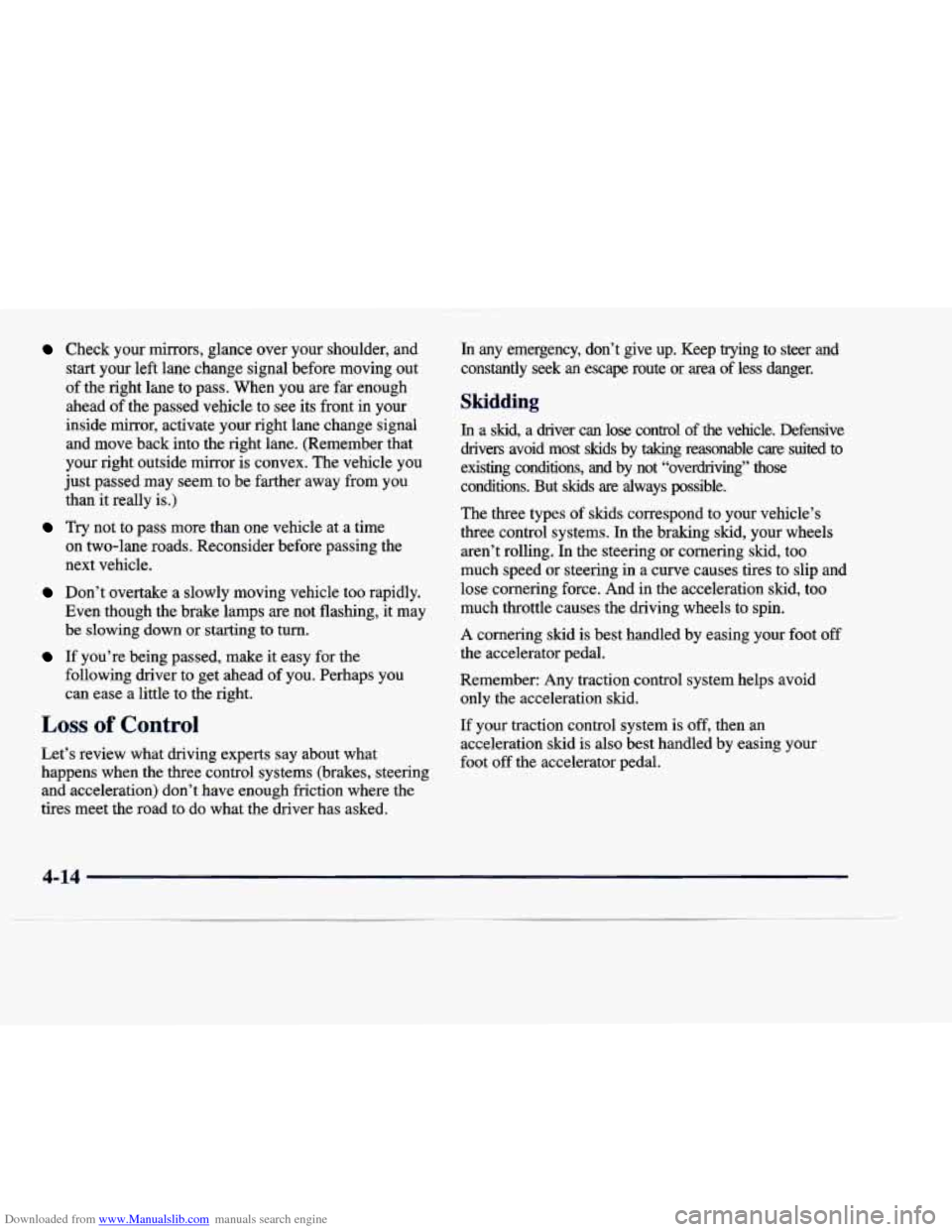
Downloaded from www.Manualslib.com manuals search engine Check your mirrors, glance over your shoulder, and start your left lane change signal before moving out
of the right
lane to pass. When you are far enough
ahead of the passed vehicle to see its front in your
inside mirror, activate your right lane change signal and move back into the right lane. (Remember that
your right outside mirror is convex. The vehicle you
just passed may seem to be farther away from you
than it really is.)
Try not to pass more than one vehicle at a time
on two-lane roads. Reconsider before passing the
next vehicle.
Don’t overtake a slowly moving vehicle too rapidly.
Even though the brake lamps are not flashing, it may
be slowing down or starting to turn.
following driver to get ahead of you. Perhaps you
can ease a little to the right.
If you’re being passed, make it easy for the
Loss of Control
Let’s review what driving experts say about what
happens when the three control systems (brakes, steering
and acceleration) don’t have enough friction where
the
tires meet the road to do what the driver has asked.
In any emergency, don’t give up. Keep trying to steer and
constantly seek an escape route or area of less danger.
Skidding
In a skid, a driver can lose control of the vehicle. Defensive
drivers avoid most
skids by taking reasonable care suited to
existing conditions, and by not “overdriving” those
conditions. But
skids are always possible.
The three types of skids correspond to your vehicle’s
three control systems. In the braking skid, your wheels aren’t rolling. In the steering or cornering skid, too
much speed or steering in a curve causes tires to slip and
lose cornering force. And in the acceleration skid, too
much throttle causes the driving wheels to spin.
A cornering skid is best handled by easing your foot off
the accelerator pedal.
Remember: Any traction control system helps avoid
only the acceleration skid.
If your traction control system is
off, then an
acceleration skid is
also best handled by easing your
foot
off the accelerator pedal.
4-14
Page 329 of 386
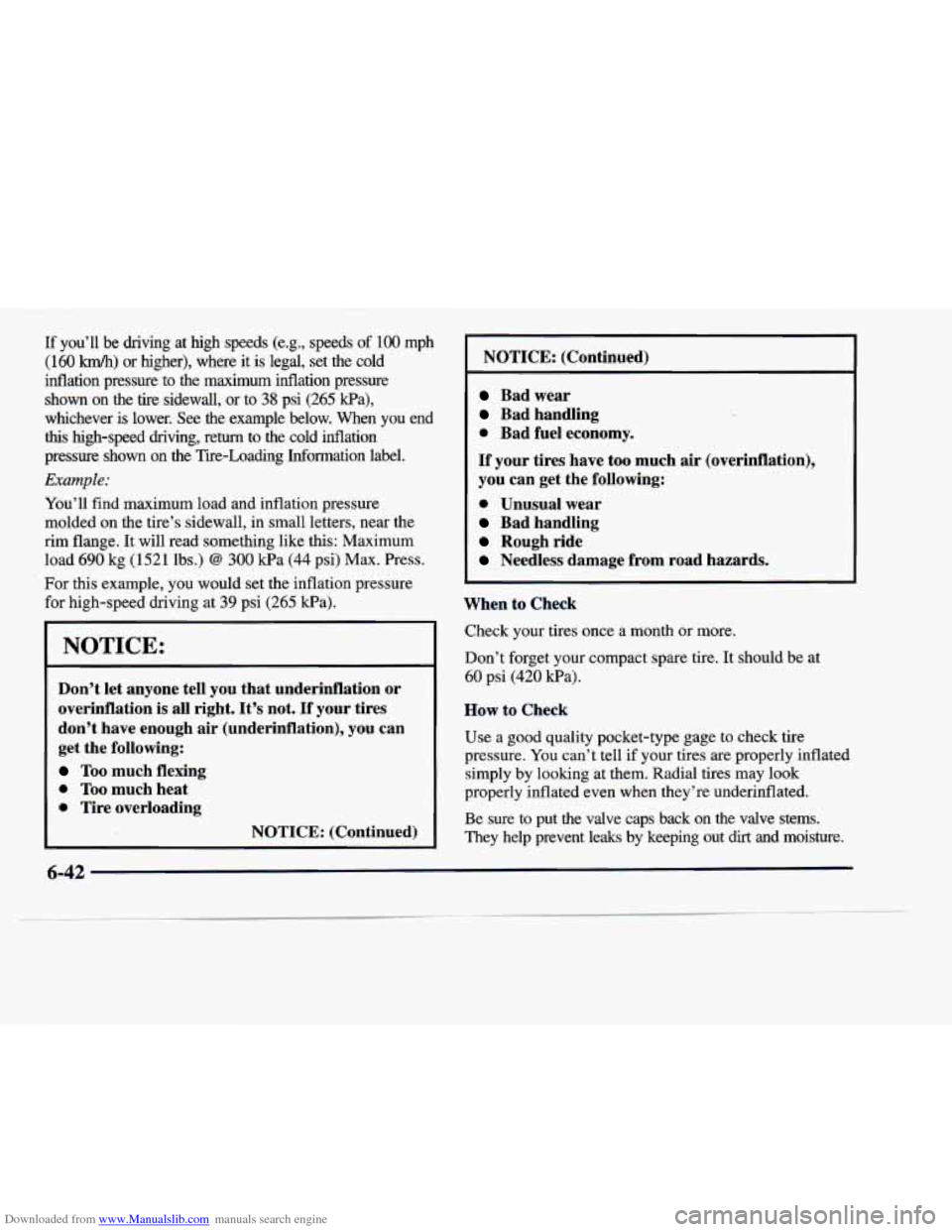
Downloaded from www.Manualslib.com manuals search engine - -
If you’ll be driving at high speeds (e.g., speeds of 100 mph
(160 km/h) or higher), where it is legal, set the cold
inflation pressure to the maximum inflation pressure shown on the
tire sidewall, or to 38 psi (265 kpa),
whichever is lower. See the example below. When you end
this high-speed driving, return to the cold inflation
pressure shown on the Tire-Loading Information label.
Example:
You’ll find maximum load and inflation pressure molded
on the tire’s sidewall, in small letters, near the
rim flange. It will read something like this: Maximum load 690
kg (1521 lbs.) @ 300 Wa (44 psi) Max. Press.
For this example,
you would set the inflation pressure
for high-speed driving at
39 psi (265 kPa).
NOTICE:
Don’t let anyone tell you that underinflation or
overinflation is all right.
It’s not. If your tires
don’t have enough air (underinflation), you can
get the following:
Too much flexing
0 Too much heat
0 Tire overloading
NOTICE: (Continued)
NOTICE: (Continued)
Bad wear
Bad handling
0 Bad fuel economy.
If your tires have too much air (overinflation),
you can get the following:
0 Unusual wear
Bad handling
Rough ride
Needless damage from road hazards.
When to Check
Check your tires once a month or more.
Don’t forget your compact spare tire. It should be at
60 psi (420 kPa).
How to Check
Use a good quality pocket-type gage to check tire
pressure.
You can’t tell if your tires are properly inflated
simply by looking at them. Radial tires may look
properly inflated even when they’re underinflated.
Be sure to put the valve caps back on the valve stems.
They help prevent leaks
by keeping out dirt and moisture.
6-42
Page 331 of 386
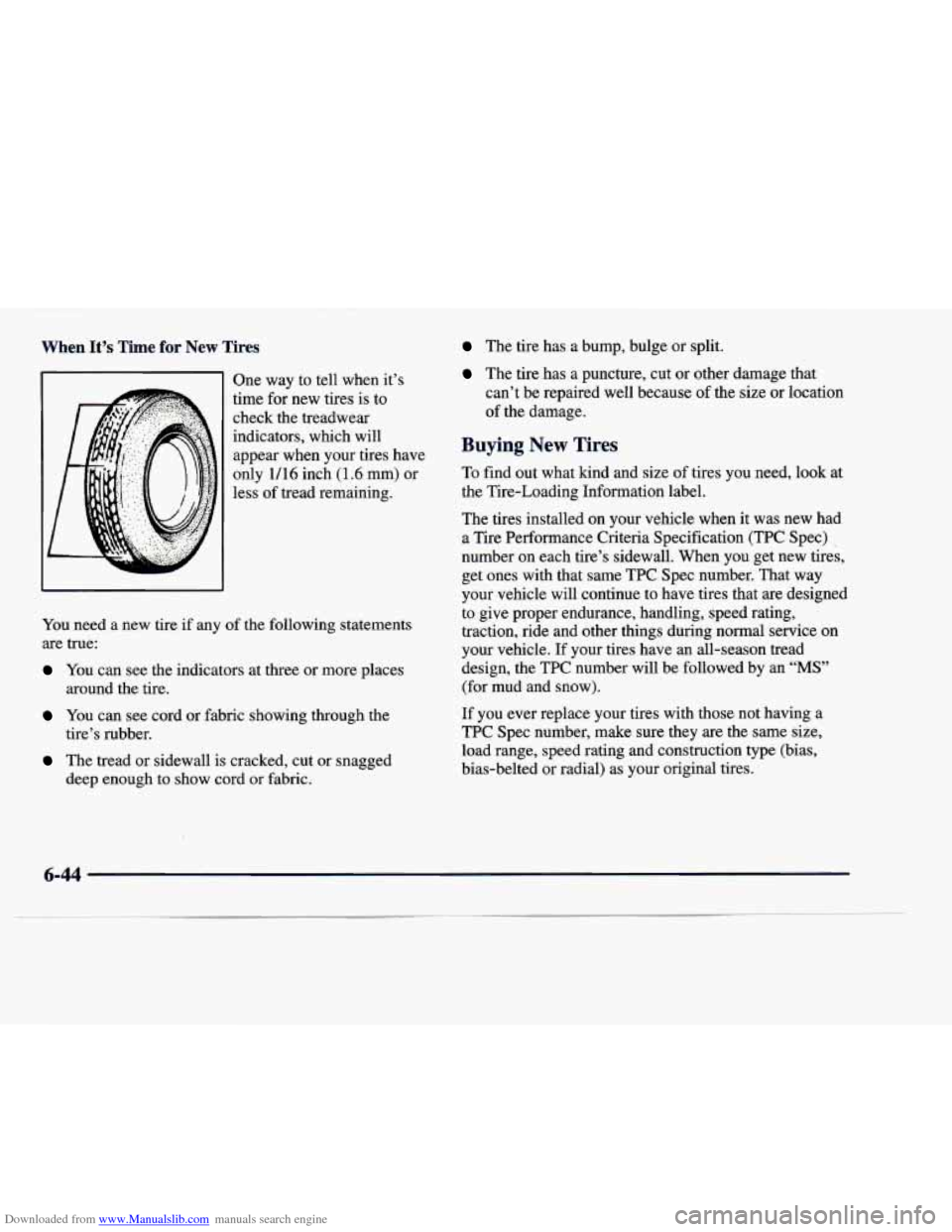
Downloaded from www.Manualslib.com manuals search engine When It’s Time for New Tires
One way to tell when it’s
time for new tires is to
check the treadwear
indicators, which will
appear when your tires have
only
1/16 inch (1.6 mm) or
less
of tread remaining.
You need a new tire
if any of the following statements
are true:
You can see the indicators at three or more places
You can see cord or fabric showing through the
The tread or sidewall is cracked, cut or snaggea
around the tire.
tire’s rubber. deep enough to show cord or fabric.
The tire has a bump, bulge or split.
The tire has a puncture, cut or other damage that
can’t be repaired well because
of the size or location
of the damage.
Buying New Tires
To find out what kind and size of tires you need, look at
the Tire-Loading Information label.
The tires installed on your vehicle when it was new had
a Tire Performance Criteria Specification (TPC Spec)
number on each tire’s sidewall. When you get new tires, get ones with that same TPC Spec number. That way
your vehicle will continue to have tires that are designed
to give proper endurance, handling, speed rating, traction, ride and other things during normal service on
your vehicle. If your tires have an all-season tread
design, the TPC number will be followed by an
“MS”
(for mud and snow).
If you ever replace your tires with those not having a
TPC Spec number, make sure they are the same size,
load range, speed rating and construction type (bias,
bias-belted or radial) as your original tires.
6-44
Page 332 of 386
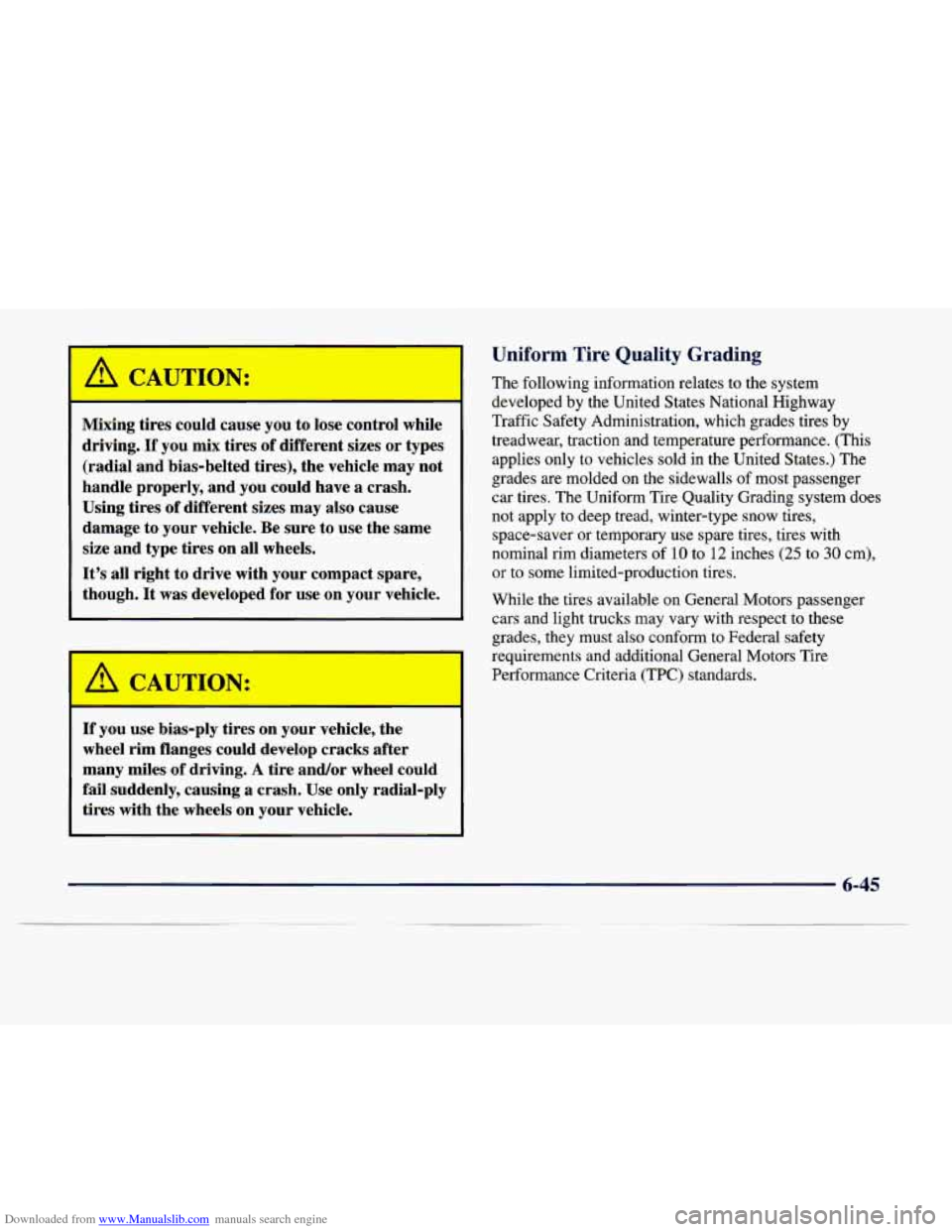
Downloaded from www.Manualslib.com manuals search engine '
A CAUTION:
Mixing tires could cause you to lose control while
driving.
If you mix tires of different sizes or types
(radial and bias-belted tires), the vehicle may not
handle properly, and you could have
a crash.
Using tires of different sizes may also cause
damage to your vehicle. Be sure to use the same
size and type tires on all wheels.
It's all right to drive with your compact spare,
though.
It was developed for use on your vehicle.
If you use bias-ply tires on your vehicle, the
wheel rim flanges could develop cracks after
many miles of driving.
A tire and/or wheel could
fail suddenly, causing
a crash. Use only radial-ply
tires with the wheels on your vehicle.
Uniform Tire Quality Grading
The following information relates to the system
developed by the United States National Highway
Traffic Safety Administration, which grades tires by
treadwear, traction and temperature performance.
(This
applies only to vehicles sold in the United States.) The
grades are molded on the sidewalls of most passenger
car tires. The Uniform Tire Quality Grading system does
not apply to deep tread, winter-type snow tires,
space-saver or temporary use spare tires, tires with
nominal rim diameters of
10 to 12 inches (25 to 30 cm),
or
to some limited-production tires.
While the tires available on General Motors passenger
cars and light trucks may vary with respect to these
grades, they must also conform to Federal safety
requirements and additional General Motors Tire
Performance Criteria
("PC) standards.
6-45
Page 335 of 386

Downloaded from www.Manualslib.com manuals search engine Used Replacement Wheels
Putting
a used wheel on your vehicle is
dangerous. You can’t know how it’s been used or
how far it’s been driven. It could fail suddenly
and cause an accident.
If you have to replace a
wheel, use
a new GM original equipment wheel.
Tire Chains
NOTICE:
Use tire chains only where legal and only when
you must. Use only
SAE Class “S” type chains
that are the proper size for your tires. Install
them on the front tires and tighten them
as
tightly as possible with the ends securely
fastened. Drive slowly and follow the chain
manufacturer’s instructions.
If you can hear the
chains contacting your vehicle, stop and retighten
them.
If the contact continues, slow down until it
stops. Driving too fast or spinning the wheels
with chains on will damage your vehicle.
6-48
Page 343 of 386
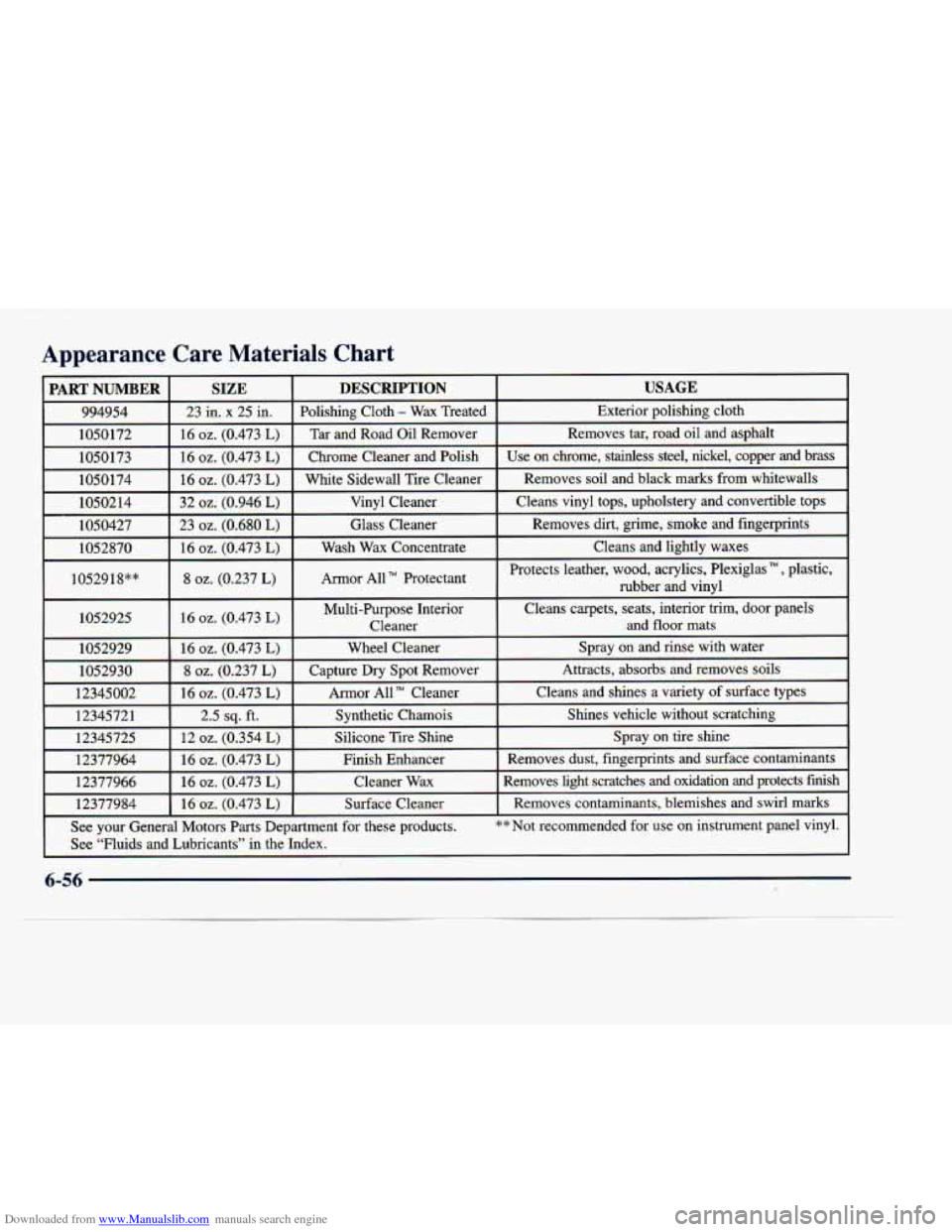
Downloaded from www.Manualslib.com manuals search engine Appearance Care Materials Chart
DESCRIPTION
Polishing Cloth - Wax Treated
Tar and Road Oil Remover
Chrome Cleaner and Polish
White Sidewall Tire Cleaner
Vinyl Cleaner Glass Cleaner
Wash Wax Concentrate
Armor All
TM Protectant
Multi-Purpose Interior Cleaner
Wheel Cleaner
Capture Dry Spot Remover
Armor All
TM Cleaner
Synthetic Chamois
Silicone Tire Shine Finish Enhancer
Cleaner Wax
Surface Cleaner
12377966
16
oz. (0.473 L)
12377984
16 oz. (0.473 L) I
See your General Motors Parts Department for these products. **Not recommended for use on instrument panel vinyl.
See “Fluids and Lubricants” in the Index.
USAGE
Exterior polishing cloth
Removes tar, road
oil and asphalt
Use
on chrome, stainless steel, nickel, copper and brass
Removes soil and black marks from whitewalls
Cleans vinyl tops, upholstery and convertible tops
Removes dirt, grime, smoke and fingerprints Cleans and lightly waxes
Protects leather, wood, acrylics, Plexiglas
TM , plastic,
rubber and vinyl
Cleans carpets, seats, interior trim, door panels and
floor mats
Spray on and rinse with water
Attracts, absorbs and removes soils
Cleans and shines a variety
of surface types
Shines vehicle without scratching Spray on tire shine
Removes dust, fingerprints and surface contaminants
Removes light scratches and oxidation and protects finish Removes contaminants, blemishes and swirl marks
6-56